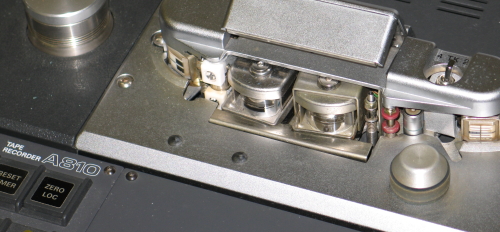A lot of work has been happening at the University of Sydney over the past six months, and at the end of last year the top floor of the Transient Building, which houses Linguistics, Paradisec and a few other offices, got renovated. Unfortunately, since the entire exterior of the building is composed of fibrous asbestos, it’s unlikely that the University will outlay the mammoth insurance costs to do any exterior work. But anyone who knows the Transient building knows that the best option would be to demolish the whole thing and start again from scratch.
The point is, since Paradisec was displaced from our usual premises for over a month, we took the opportunity of the forced hiatus to have some work done on the machine that lies at the heart of our organisation; a Studer A810 MkII reel-to-reel tape machine. We’ve had a conversion done to the headblock assembly (pictured) that saw the removal of the recording head – since we doubt we’d ever need to record onto tapes – and its replacement with a quarter-track reproduce, or playback head.

Our pride and joy: an original Studer A810 MkII tape recorder player.
Since lugging around boxes of blank reel-to-reel tapes would have been so difficult, especially in such inaccessible locations as the highlands of Papua New Guinea or the remote islands of the Pacific, field-workers in that era were naturally doing whatever they could to fit more data onto less tape. Mostly this involved recording one mono track onto each side of a tape, effectively doubling the length of a normal stereo recording. Digitising a tape like this is easy; you play it in stereo, then split it into two separate files and reverse the right channel (since it was recorded in the reverse direction and therefore plays backwards). The only loss of audio quality using this method is that there’s no stereophonic effect, which isn’t all that important for linguistic or anthropological recordings.
Other times, field workers would slow the spooling speed on their machine right down so as to fit as much on a single tape as possible. This had the unfortunate consequence of significantly affecting the fidelity of the recording – the difference between 3.75 ips and 1.875 ips, half-speed, is that most of the higher-end of the spectrum doesn’t make it onto the tape, meaning you lost most of your sibilants and stops – two things that are important for linguistic recordings. Since the Studer’s slowest playback speed is 3.75 ips, our only option is to ingest slower tapes at that speed and halve the sample rate from 96 to 48 kHz. This has the effect of playing the recording at real-speed, without altering the original audio information whatsoever. Once though, I had a tape recorded at half that again; 0.9375 ips or fifteen sixteenths of an inch per second. This means that the slowest speed we could have played it back was too fast by a factor of four! In this case, the audio quality was so poor that resampling it to the right speed still only resulted in a file that was barely audible.
Another way in which field-recorders used to conserve tape was to record in quarter-track mode instead of half-track. This means the width of the quarter-inch magnetic tape contains four discrete channels as opposed to two, but it also means that most production tape machines are unable to play them back. This is where the conversion to our Studer fits in. By removing the redundant record head, and replacing it with a quarter-track playback head, we’re now able to play either half- or quarter-track tapes with the mere flick of a switch. However, since the machine still only has two actual channels, a quarter-track tape will have to be played once in each direction, each time digitising two of the four channels.
Now that the Studer’s operational again, I’ve been working my way through the backlog of tapes still needing to be digitised and the size of our collection of archived materials is steadily growing towards the 2000 hour mark. We currently have 107 collections, comprising 3614 items and almost 27,000 individual files totalling about 3.45 terabytes of space in our digital repository at APAC in Canberra. I’ve given a fuller breakdown at the end.
At the same time, more and more collections are coming in. We will soon be digitising some tapes recorded over the last 20 years of the Yagwoia language from the Morobe province of Papua New Guinea. As far as I can tell, there has been very little work done on Yagwoia and it appears that currently, no recordings exist in any archive. So we certainly look forward to adding these recordings to our collection.
Special thanks to Greg Moss of the National Film and Sound Archive for his advice on where to get the headblock converted and the capstan assembly serviced, and for his help in calibrating the new quarter-track head.
Repository Metrics
Collections : 107 collections
Items : 3,614 items
Files : 26,940 files
Size : 3.45 TB
Time : 1926:05:20.00
File Type Metrics
Type Files Size Duration .... ...... ......... ............. .dv 23 23.44 GB 00:00:00.00 .eaf 2 229.08 KB 00:00:00.00 .img 8 24.75 GB 00:00:00.00 .jpg 14,553 20.14 GB 00:00:00.00 .mov 61 485.53 GB 00:00:00.00 .mp3 5,774 103.22 GB 1924:13:40.00 .mp4 6 2.22 GB 00:00:00.00 .mpg 20 13.49 GB 00:00:00.00 .pdf 81 487.25 MB 00:00:00.00 .rtf 26 4.49 MB 00:00:00.00 .tif 357 1.61 GB 00:00:00.00 .trs 17 390.08 KB 00:00:00.00 .txt 207 16.44 MB 00:00:00.00 .wav 5,774 2.80 TB 1926:05:20.00 .xml 31 1.20 MB 00:00:00.00 ...... ......... ............. 26,940 3.45 TB 3850:18:20.00
 Follow
Follow